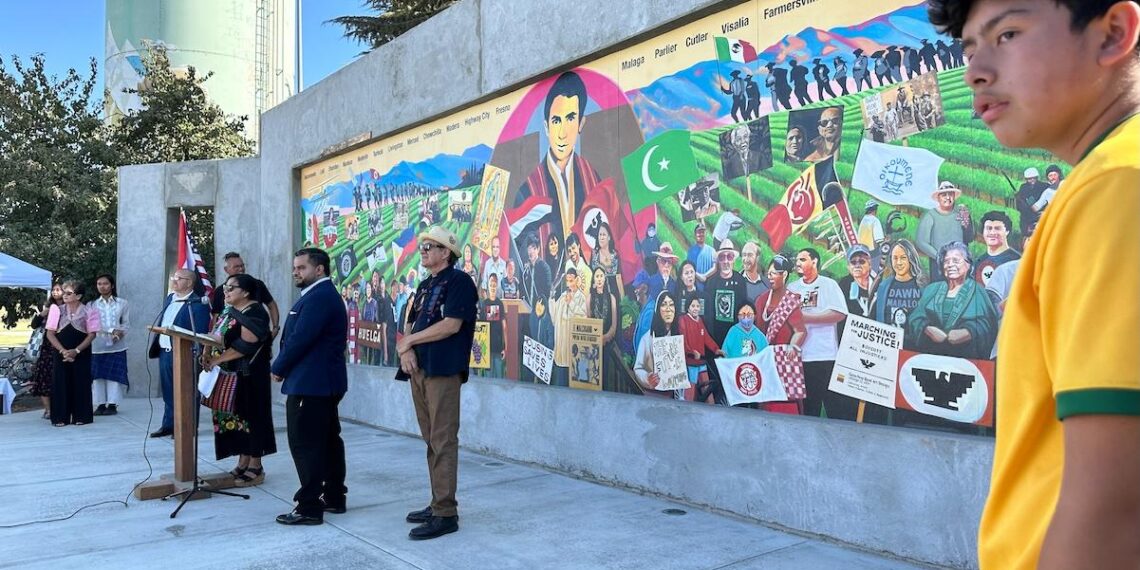POPLAR – More than 50 years after the murder of Yemeni farm worker Nagi Daifallah, a diverse gathering of Poplar residents came together on a recent weekend to honor the organizer’s memory, and to demand justice for his killing.
Organizers also unveiled a mural inspired by the slain activist, whose death helped propel the fight for farm worker rights.
The October 20 gathering drew hundreds and reflected the rich diversity of this small, mostly agricultural community in California’s Central Valley. Mexican, Filipino, Yemeni and Indigenous residents marched from the Larry Itliong Resource Center — named for the celebrated Filipino civil rights leader — to the newly named Nagi Daifallah Unity Park.
“Today is the culmination of years of reflection on the work of our predecessors, especially Nagi Daifallah,” said Arturo Rodríguez León, director of the Poplar Community Services District, a position roughly akin to mayor.

Situated on the site of a former United Farm Workers (UFW) branch office, residents pushed for and eventually succeeded in winning the Poplar City Council’s approval for the park’s renaming in honor of Daifallah.
“It was here where the first fields were organized under contract with César Chávez and Larry Itliong,” noted Rodríguez, adding that local white ranchers opposed to the organizing efforts quickly turned to violence in an attempt to suppress the movement.
“That is when the Arab community united with Filipinos and Mexicans to protect themselves and combat racism. The police didn’t come to help. The following year they killed Nagi,” he said.
Not all in the community have embraced the mural
A campaign to remove it is currently underway, led by the Pleasant View Elementary School District and Lower Tule River Irrigation District, which have accused city officials of misappropriating funds designated for the park and have opened a Grand Jury investigation.
“The ranchers who opposed the (UFW) and continue to oppress the community are the same ones who do not want the mural,” said Rodríguez.
A bridge between communities

Daifallah died at age 24 on the morning of August 15, 1973. He was among a group of picketers outside the Smokehouse Cafe in Lamont, California, some 70 miles south of Poplar, when a group of three Kern County sheriff’s deputies arrived.
Sheriff’s Deputy Gilbert Cooper targeted picket captain Frank Quintana and attempted to arrest him for allegedly disturbing the peace.
Quintana and the picketers fled, and when Daifallah began to run, Cooper caught up with him and hit him on the head with a metal flashlight, causing him to fall to the ground. The officers then dragged his unconscious body to their vehicle and refused to help him even as blood flowed from his head.
Daifallah died later that day.
An immigrant from Yemen, Daifallah taught himself English and Spanish. He worked as a translator and was a key go-between for Arabic- and Spanish-speaking farm workers looking to join the strike.
In 1975, two years after his death, the state of California passed the Agricultural Labor Relations Act, which finally granted farm workers collective bargaining rights.
Pushing for justice
Saqr Alrafai is a licensed chiropractor with offices in nearby Visalia. An immigrant from Yemen, he said he learned about Daifallah from the farm workers who are his patients.
“I started investigating, looking for any information that could lead not only to his legacy, but how his legacy impacted different communities,” said Alrafai, who along with several others met with California State Attorney General Rob Bonta the day prior to the march seeking justice for Daifallah’s killing.
“We had a meeting with the Attorney General, and we brought the family of Nagi… they expressed how devastated they were back home after he died,” noted Alrafai, who said the group submitted a formal request for Bonta to open an investigation to determine if “justice was served our not.”
Many of the gains in farm worker rights have come because of the sacrifice of individuals like Daifallah, Alrafai stressed. “It’s really important that we teach our kids, teach the next generations about those impacts.”
Ahmed Almori is 72 and knew Daifallah personally, the two having once shared a room in one of the modest farm worker quarters that to this day many farm workers rely on for shelter. He described Daifallah as a hard-working man who liked to bring people together.
“When he met César Chávez, he was very surprised with what he had started and wanted to join that group and expand it,” said Almori, who recalled falling into a deep depression after Daifallah’s death.
“It brings back memories,” said Almori, gazing at the crowd around him, and maybe “some justice.”
A ‘catalyst for change’

Mexican cowboys — charros — on horseback, Filipino women dressed in traditional attire, and young Indigenous people singing and playing drums were among those gathered Sunday. Members of the Yemeni community were also on hand as a young African American woman performed the US national anthem.
Mari Pérez Ruiz with the Central Valley Empowerment Alliance noted the mural depicts the colorful diversity of the community.
“We decided we didn’t just want a pretty mural,” she said but a painting where the community could see itself.
“That’s how we grow,” she continued, adding, “The experience of Yemeni farm workers was erased. The story of our Filipino experience was also erased. It is important for us to bring those stories back.”
More than $250,000 was raised to pay for the mural and overall park project.
“Our responsibility is to make sure we protect it,” said Alrafai, “including from those now running for office who have said that the first thing they will do once they are elected is to remove the mural.”
Artist Carlos Pérez David, part of the team that worked on the original design, said he felt honored to do the mural.
“This is part of my life,” he said, recalling his own childhood in Stockton where he also once worked the fields. “It reflects everyone: children, Indigenous people, Filipinos, Mexicans, African Americans. I tried to represent all the people who work in the fields.”
The mural is the first of its kinds in Tulare County.
“We hear a lot about César Chávez and Dolores Huerta, and they did a lot of work, but they didn’t do it alone,” said Ruiz. “Nagi played an instrumental role.”
Araceli Martínez reports for the Spanish language newspaper La Opinión in Los Angeles. She produced this story for EMS as part of our Stop the Hate initiative, with funding provided by the State of California, administered by the California State Library in partnership with the California Department of Social Services and the California Commission on Asian and Pacific Islander American Affairs as part of the Stop the Hateprogram. To report a hate incident or hate crime and get support, go to CA vs Hate.

































